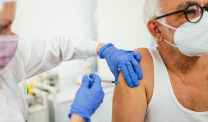Weighing the Value, Benefits of Continued Drug Tests on Chimpanzees
Research & Clinical TrialsWritten by Michelle Whitmer • Edited By Walter Pacheco
Asbestos.com is the nation’s most trusted mesothelioma resource
The Mesothelioma Center at Asbestos.com has provided patients and their loved ones the most updated and reliable information on mesothelioma and asbestos exposure since 2006.
Our team of Patient Advocates includes a medical doctor, a registered nurse, health services administrators, veterans, VA-accredited Claims Agents, an oncology patient navigator and hospice care expert. Their combined expertise means we help any mesothelioma patient or loved one through every step of their cancer journey.
More than 30 contributors, including mesothelioma doctors, survivors, health care professionals and other experts, have peer-reviewed our website and written unique research-driven articles to ensure you get the highest-quality medical and health information.
About The Mesothelioma Center at Asbestos.com
- Assisting mesothelioma patients and their loved ones since 2006.
- Helps more than 50% of mesothelioma patients diagnosed annually in the U.S.
- A+ rating from the Better Business Bureau.
- 5-star reviewed mesothelioma and support organization.
Testimonials
My family has only the highest compliment for the assistance and support that we received from The Mesothelioma Center. This is a staff of compassionate and knowledgeable individuals who respect what your family is experiencing and who go the extra mile to make an unfortunate diagnosis less stressful. Information and assistance were provided by The Mesothelioma Center at no cost to our family.LashawnMesothelioma patient’s daughter
How to Cite Asbestos.com’s Article
APA
Whitmer, M. (2022, December 19). Weighing the Value, Benefits of Continued Drug Tests on Chimpanzees. Asbestos.com. Retrieved April 19, 2024, from https://www.asbestos.com/news/2013/10/18/animal-testing-chimpanzee-cancer-research/
MLA
Whitmer, Michelle. "Weighing the Value, Benefits of Continued Drug Tests on Chimpanzees." Asbestos.com, 19 Dec 2022, https://www.asbestos.com/news/2013/10/18/animal-testing-chimpanzee-cancer-research/.
Chicago
Whitmer, Michelle. "Weighing the Value, Benefits of Continued Drug Tests on Chimpanzees." Asbestos.com. Last modified December 19, 2022. https://www.asbestos.com/news/2013/10/18/animal-testing-chimpanzee-cancer-research/.

Research on nonhuman primates began relatively innocently with behavior studies in the 1920s in the United States. By the 1940s, biomedical research using chimpanzees was underway.
Since then, many cancer drugs and therapies have been tested on nonhuman primates (NHP), and according to decades of research, the results seldom predict how a human will respond.
Chimpanzees are our closest evolutionary relatives. Current estimates put the amount of shared genes between chimps and humans around 70 percent. As recently as 2005, scientists thought our genes were 96 percent identical to chimps.
For decades animal studies have formed the foundation of mesothelioma research. The most common subjects in preliminary mesothelioma studies are mice and rats, and nonhuman primates are sometimes used to test new cancer drugs and therapies. Scientists have justified the use of nonhuman primates because of the amount of shared genes between humans and NHPs.
Yet, in 2006, the U.S. Food and Drug Administration reported that 92 percent of the drugs that succeed in animal trials do not receive approval in human clinical trials.
“Currently, nine out of ten experimental drugs fail in clinical studies because we cannot accurately predict how they will behave in people based on laboratory and animal studies,” explained Health and Human Services Secretary Mike Leavitt in a press release urging researchers to implement newer technologies that produce more reliable results.
Many of the drugs that are investigated in Phase I mesothelioma clinical trials are based off results from preliminary studies in animals. And, unfortunately, the vast majority of mesothelioma clinical trials don’t make it to phase II. It isn’t uncommon for a Phase I mesothelioma trial to be abandoned before completion because the drug isn’t producing the same results in humans that it did in animals.
Earlier this year, the National Institutes of Health (NIH) asked the public to respond to the recommendations recently made by the organization’s Working Group on the Use of Chimpanzees in NIH-Supported Research. More than 12,500 people responded, and most of them called for a total end to invasive chimp research. Once implemented, the working group’s recommendations could greatly impact the use of nonhuman primates in scientific research in the United States.
Currently, the United States is the only industrialized nation that continues to conduct invasive experiments on chimpanzees. Gabon, located on the west coast of Central Africa, is the only other country that also does invasive tests on chimps.
Close, But Not Quite
Despite the 70 percent genetic likeness, identical genes don’t translate into identical gene expression. And, despite the apparent similarities, more than 40 million differences in three billion DNA molecules between chimps and humans adds up to a world of difference. Some of the genetic differences between chimpanzees and humans:
-
20 out of the 333 genes associated with cancer are different
-
560 genes contain differences that affect the immune system
-
965 genes are expressed in humans, but not in chimpanzees
-
humans have 23 pairs of chromosomes and chimps have 24 pairs
-
80 percent of proteins (which greatly affect cancer development) are different in chimps and humans
These genetic differences cause drugs to behave differently in NHPs than in humans, and evidence of the difference is documented in countless failed clinical trials. For example, all of the 50-plus AIDS vaccines that proved effective in nonhuman primates have failed in human trials. In another example, hormone replacement therapy that effectively prevented stroke and heart disease in NHPs ended up increasing the risk for both in humans.
According to Dr. Jarrod Bailey, who conducted a critical review on nonhuman primates in medical research and drug development in 2005, “Every area of research in which NHPs have been used provides evidence against its utility [and] there is a great deal of often overlooked data showing NHP research to be irrelevant, unnecessary, even hazardous to human health and to have little or no predictive value or application to human medicine.”
NHPs in Mesothelioma Research
Often a drug won’t cause significant side effects in NHPs, but will produce potentially troublesome effects in humans.
In 1996, nonhuman primates were used in a gene therapy study that investigated the toxicity the adenovirus carrying an altered thymidine kinase gene for pleural mesothelioma. The altered adenovirus was injected into the pleural cavity of three NHPs, and no obvious adverse reactions were observed, just inflammation that was only visible under a microscope. In a later phase I clinical trial of the altered virus in mesothelioma patients, side effects included fever, anemia, elevated liver enzymes, and systemic inflammatory response. No phase II trial was planned after those results were reported.
Occasionally, a drug will cause the same side effect in humans that it does in NHPs.
Preliminary testing of an immunotherapy drug called fresolimumab (GC1008) in nonhuman primates caused keratoacanthoma-type skin lesions, a form of skin cancer, to develop. Fresolimumab was tested in 13 mesothelioma patients in a Phase II clinical trial between 2010 and 2012.
However, the drug manufacturer pulled the plug on developing fresolimumab as a cancer therapy because the drug wasn’t showing great promise in treating cancer. Before the manufacturer backed out, one of the mesothelioma patients developed the same cancerous skin lesions that primates developed.
Could these cancerous skin lesions have been prevented in both the NHP and the mesothelioma patient if newer technologies were used to test the drug’s effects on actual human cells outside of a person’s body?
New Methods, More Accurate Results
Approximately 50 different alternatives to animal testing are validated and accepted by international regulatory agencies. Testing products like EpiSkin, “organs-on-a-chip” and Modular Immune In vitro Construct (MIMIC) are using human cells to more predictably assess a drug’s effect in people than animal testing. And these products are much cheaper than maintaining animals for research.
Many organizations including the pharmaceutical giant Novo Nordisk have transitioned to nonanimal testing methods. Most often, their motivation for switching to nonanimal methods is economic and not ethical. Animal testing is expensive, largely because of housing, feeding and veterinary costs.
A Dying Industry
By the age of 19, Bobby, a chimpanzee born in captivity, had undergone anesthesia more than 250 times and was subject to countless biopsies. Bobby spent most of his time in a cage and became depressed, leading him to bite his own arm repeatedly. When the research facility that housed him closed in 2002, Bobby was moved to the Save the Chimps sanctuary in Fort Pierce, Fla., where he now socializes and mingles freely with other chimps.
Bobby was lucky. Not all retired chimps end up in a sanctuary. Many are moved to another lab and continue living in cages. But animal rights activists are lobbying for legislation, such as the Great Ape Protection and Cost Savings Act, which could one day help more NHPs to retire in sanctuaries instead of cages.
Soon, the animal testing industry which historically reports high profits for the research conducted on its animals may take a hit in the U.S. once the NIH implements the recommendations set forth by Working Group on the Use of Chimpanzees in NIH-Supported Research.
In 2010, the NIH announced plans to bring 186 semi-retired chimpanzees back into active research. The American public responded with protests, causing the NIH to commission a study with the Institute of Medicine (IOM) to reassess the need for chimps in biomedical research.
The IOM study concluded that, “While the chimpanzee has been a valuable animal model in past research, most current use of chimpanzees for biomedical research is unnecessary.”
NIH accepted the IOM study in December 2011 and stated that it would not fund any new research involving chimpanzees. Since then, the Working Group on the Use of Chimpanzees in NIH-Supported Research has developed 28 recommendations. In June 2013, NIH announced plans to provide the guidance and assistance necessary to implement the 28 recommendations, including the decision to retire the majority of NIH’s chimps.
A big part of the NIH plan is to reduce its collection of chimpanzees which totaled 734 in 2011 to approximately 50 chimps. Roughly two-thirds of the chimps available for research in the U.S. are owned or supported by the NIH. In 2011, NIH was spending $12 million a year caring for their chimps.
About 124 of the NIH’s chimps reside at the New Iberia Research Center (NIRC) in Louisiana. The NIRC received national attention in 2009 when the ABC news show “Nightline” aired an undercover documentary showcasing the animal abuse taking place at the center.
The U.S. Department of Agriculture (USDA) initiated an investigation after the documentary aired and slapped NIRC with an $18,000 fine. In May 2013, the NIRC paid a $38,571 federal fine for negligence that led to the death of three rhesus monkeys and injury to a chimpanzee. And, in August 2013, the USDA released a report citing NIRC for federal violations that led to the escape of five capuchin monkeys and the death of a macaque monkey.
Animal testing is often justified on a belief that human life is more valuable than another animal’s life. Debating the value of a human life versus a dog’s life or a monkey’s life doesn’t happen much in scientific circles. Animal rights activists, who say the ethical treatment of animals doesn’t matter much to modern medicine yet, have finally hit scientists with a serious weapon: Scientific data that proves the futility of animal testing a 92 percent fail rate cannot be ignored.
Considering that mesothelioma is one of the more underfunded cancers in terms of research dollars, advocates question the amount of funding that goes to animal-based mesothelioma research.
Mesothelioma advocates can’t help but wonder: Would more mesothelioma drugs make it to market if preliminary testing was performed on human cells rather than animals?







